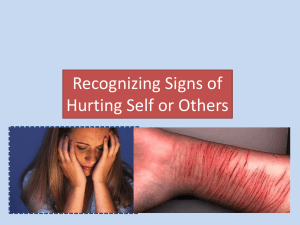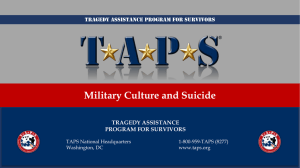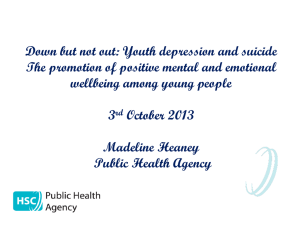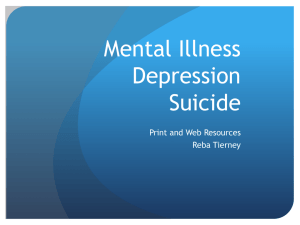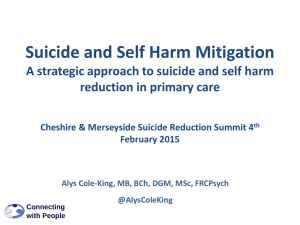Retention and Student Mental Health
advertisement
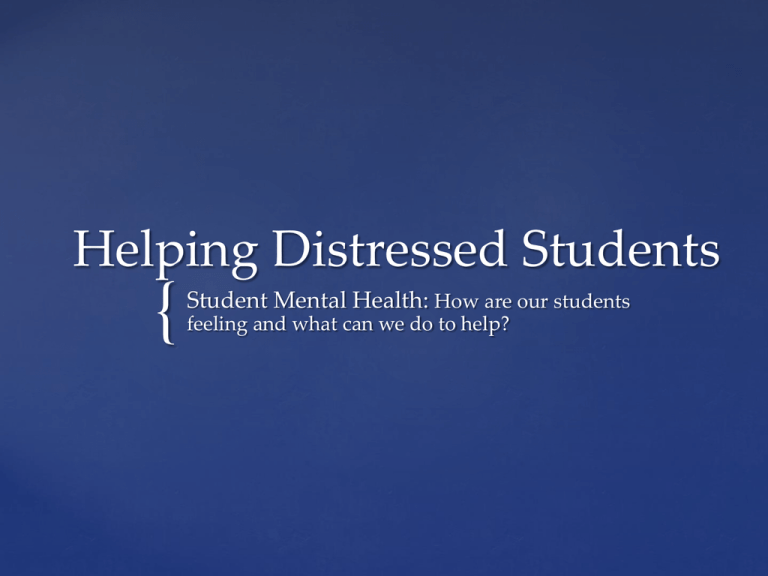
Helping Distressed Students
{
Student Mental Health: How are our students
feeling and what can we do to help?
•
•
•
State of student mental health today
How we got to this point
What we can do to help
Student Mental Health
Historically, college student mental
health was considered from a
developmental view
•
•
Focused on transition issues of moving from
high school to college
Issues related to academics, homesickness,
finances, dating relationships, extracurricular
activities, parental issues, and racial and cultural
issues
The World isn’t getting crazier; college is just
getting more like the world around it.
H.E. Marano, 2002
Suicide is the 2nd leading cause of death among college students
• 80% of students who die by suicide have never been seen by
campus mental health service providers.
• Only 29% of college students report receiving suicide prevention
information from their schools. The good news, this is up from
14% in 2006.
• Over 1,100 students die each year from suicide, approximately
3 a day.
Students at risk
• Those with a pre-existing mental illness.
• Those that develop mental illnesses while in college.
• Those lacking coping and other life skills.
• Those who stop their mental health related treatments while
away from home.
Today
•
•
•
•
Students reporting a diagnosis of clinical
depression increased from 10% in 2000 to 18%
in 2008 (NCHA)
Rate of depression is typically higher in college
than in the general population (Pace & Trapp,
1995)
o Women 21%
Men 13%
80% of students with depression also have
symptoms of anxiety and 60% have physical
symptoms
People with depression are at increased risk for
co-occurring substance abuse, panic disorder,
obsessive-compulsive disorder, and suicide
Today
•
92% of depressed students show
signs of academic impairment
o
•
70% of students seeking
counseling center services
reported that personal problems
were affecting academic progress
o
Today
Heiligenstein, et al., 1996
Turner, 2000
Stress is the number one factor impeding
college student success (ACHA, 2009)
Impediments to Academic Success
•
•
•
•
•
•
•
27.2% Stress
19.3% Sleep problems
18.2% Anxiety
15.4 % Cold/Flu/Sore Throat
13.1% Work
11.3% Concern for a troubled friend/family member
11.2% Depression
(37 unique categories listed, the above were the 7 with a prevalence greater than 11%)
Today
Effects of Stress and Anxiety
Study by the John Hopkins
Children’s Center (June 2010)
•
12% of college students studied stated they had
thought about committing suicide at least once in
the past year
o
o
•
25% of these thought about suicide repeatedly
7% of these made specific plans
Greatest risk factors
•
Depression and lack of social support
o
•
Today
Defined as feeling unappreciated, unloved and
uninvolved with family and friends
Childhood exposure to domestic violence and having
a mother with depression also increased risk
The American Freshman: National Norms Fall 2010
•
The % of students rating their emotional health as below
average rose to a record level
o
o
•
Students feeling frequently overwhelmed during their
senior year of high school rose from 27% to 29%
o
•
Students rating their emotional health as above average fell
to 52%, compared to 64% in 1985
Gender gap: women have a less positive view than men
Gender gap: 18% for men and 39% for women
Contrast the above with 75% of students seeing
themselves as above average in their “drive to achieve
and their academic ability”
Today
A recent Michigan State study found the critical event
having the most influence on whether students drop
out of school is depression.
•
•
•
Loss of financial aid was next in influence
Other major influences include
o Being recruited by an employer or another school,
experiencing a large increase in tuition or cost of
living, an unexpected bad grade, and roommate
conflicts
Students were less sensitive to events such as
o Death of a family member, inability to enter their
intended major, substance abuse, coming into a large
sum of money, and becoming engaged or married
Today
Factors affecting retention and graduation at NDSU
1. Level of student commitment to earning a degree
2. Level of student motivation to success
3. Student study skills
4. Student educational aspirations and goals
5. Student personal coping skills
6. Student mental or emotional health issues
7. Amount of financial aid available to students
8. Level of emotional support from family, friends, etc.
9. Level of certainty about career goals
NDSU Survey
Used with permission from ACT
n=3356, return rate of 25.4%
University of Michigan Public Health Study
•
•
Students with depression are twice as likely to
drop out of school
Students with depression and/or anxiety have
especially poor academic performance
o
o
Today
If you compare students at the 50th percentile of
the GPA distribution to a student with depression,
there is a 13% drop in GPA
If you add anxiety into the mix, the student drops
to the 23rd percentile (over 50% drop)
University of Wisconsin-Stout Study
•
Concluded that students at risk for mental
health concerns are more likely to be retained if
they receive treatment for their concerns
o
o
The more severe the distress, the more
intervention is needed
An example: Psychosis and Auditory
Hallucinations
Today
Psychosis is a disorder in which a person has lost
some contact with reality
Bipolar disorder (2.6%), Schizophrenia (1.1%)
•
•
•
•
Increased academic pressure,
competitiveness, and sleep deprivation
Fewer students take time off to stabilize
after stress or mental health problems
Students stop taking medications when
they get to college
o Worried about stigma; want to use
alcohol/drugs
Students using alcohol or drugs while on
medications cause interactive problems
Why are students so anxious
and distressed?
•
Increased similarity between college
population and general population
o
•
•
Why?
Greater availability of medications and
counseling services allows individuals to
attend school who would not have been
able to in the past
Less stigma attached to mental illness
and the use of counseling
Students already under care may stop
when they get to college
•
•
•
•
Why?
Students believe their generation will be
less successful than their parents, so there
is more pressure to succeed
Economy and parental unemployment
“Hyper-enriched lives” with cell phones,
computers, classes, jobs, sports, travel,
volunteer work and more
Lack of academic readiness: being
awarded superior grades in high school
without learning how to study
Facing the facts…
Death by Suicide and Psychiatric Disorders
Psychological autopsy studies done in various countries over almost
50 years report the same outcomes:
90% of people who die by suicide are suffering from one or more
psychiatric disorders:
• Depression
• Especially when combined with alcohol and drug abuse
• Bipolar disorder
• Alcohol abuse and dependence
• Drug abuse and dependence
• Schizophrenia
Other psychiatric risk factors with potential to result in suicide
(account for significantly fewer suicides than Depression)
• Post Traumatic Stress Disorder (PTSD)
• Eating disorders
Myths Versus Facts
About Suicide
MYTH:
Suicide occurs in greater numbers around holidays
in November and December.
FACT:
The highest rates of suicide are in April, while the
lowest rates are in December.
Myths versus facts…
MYTH:
Sometimes a bad event can push a person to
complete suicide.
FACT:
Suicide results from serious psychiatric disorders, not
just a single event. One bad event will not normally push
someone without a psychiatric disorder to commit suicide.
One caveat, when dealing with youth and young
adults, impulsiveness needs to be taken into consideration.
Myths versus facts…
MYTH:
Once a person attempts suicide the pain and
shame will keep them from trying again.
FACT:
The most common psychiatric illness that ends in
suicide is Major Depression, a recurring illness. Every
time an individual gets depressed, the risk of suicide
returns.
Myths versus facts…
MYTH:
Asking a depressed person about suicide will push
him/her to complete suicide.
FACT:
Studies have shown that individuals with
depression often have suicidal thoughts and talking about
them does not increase the risk of a person taking their
own life.
Myths versus facts…
MYTH:
Males are more likely to be suicidal.
FACT:
Men COMPLETE suicide more often than
women. However, women attempt suicide three times
more often than men.
Myths versus facts…
MYTH:
People who talk about suicide don’t complete
suicide.
FACT:
Many people who die by suicide have given
definite warnings to family and friends of their
intentions. Always take any comment about suicide
seriously.
Myths versus facts…
What do we know about the
impulsiveness of youth suicide?
Among all 18-24 year olds who die by suicide:
• 1 in 5 occur on the same day as an acute life crisis
• 1 in 4 occur within 2 weeks
•Almost 50% are due to intimate partner problems
• Other reasons include:
o Legal/criminal (20%)
o Financial (12%)
o Relationship problem with friend or family (13%)
Due to the impulsiveness of youth, it is crucial to provide immediate help, develop
means for students in crisis to cope, provide a safe haven, and ensure a support
system is in place.
“The solution lies in being aware of it,
intervening earlier and providing support with
adequate and appropriate services.”
Nuran Bayram and Nazan Bilgel
Uludag University, Bursa, Turkey
Bayram & Bilgel, 2008
Mental Health & Retention
The Bottom Line
•
•
•
•
Students with social and emotional
problems are at a higher risk for dropping
out of school
Students in counseling have a higher
retention rate than those who are not
Counseling helps students address their
concerns and stay in school
It’s all about relationships!
Retention
Spectrum of Mental Health Interventions
Prevention
Early Intervention
Treatment
Well
Becoming
Unwell
Unwell
Recovering
What can we do to help?
Distressed
Disruptive
Behavior that causes us to feel alarmed, upset or
worried (most common)
Behavior that interferes with or interrupts the
educational process of other students or the
normal business operations of the university
Dangerous
Behavior that leaves us feeling frightened and in
fear for our personal safety or the safety of others
Distressed, Disruptive, or Dangerous
Be Aware of Warning Signs
•
•
•
•
•
•
•
•
•
Depressed mood, social withdrawal, negative
self-esteem, poor concentration
Changes in weight or sleep patterns
Loss of confidence, interest, and motivation
Increased anxiety, obsessive worry
Productive vs. destructive anxiety
Increased use of alcohol/drugs
Excessive procrastination
Too frequent of office visits (dependency)
Crying
What can we do to help?
Be Aware of Warning Signs
•
•
•
•
•
•
•
•
•
•
Decreased quality of work
Listlessness, sleeping in class
Marked changes in personal hygiene
Threats to self or others
Impaired speech or disjointed thoughts
Marked changes in behavior
Absence from class
Under responding to academic notices
Incongruous affect (smiling while crying)
Lack of follow-through
What can we do to help?
If You See It – Say It
When someone engages in risky, unhealthy, or suicidal behaviors here is a simple,
caring, but assertive way to talk to them.
•
•
•
•
•
•
I care. Express your concern and care first.
I see. Describe what you see or have noticed.
I feel. Use a feeling word (e.g., worried, concerned).
I’m listening. What is going on for you?
Have you been thinking of suicide, hurting yourself?
I want. I want you to talk with someone at the Counseling Center, involve your
parents, etc.
• I will. I will help you make an appointment, give you a ride, go with you, call
you tonight, etc.
Get help immediately if someone is actively suicidal, do not leave them alone.
The Counseling Center or a local emergency room are your best options.
Intervention: Three Basic Steps
1. Show you care
2. Ask about suicide
3. Get help
You can help. . .
http://www.ndsu.edu/fileadmin/counsel
ing/COUN_6542_Pamphlet.pdf
Counseling Center Web Site
Decision Making Tree
Mental Health First Aid is the help offered to a person
developing a mental health problem or experiencing a
mental health crisis. The first aid is given until
appropriate treatment and support are received or
until the crisis resolves.
Just as CPR training helps a layperson without medical
training assist an individual following a heart attack,
Mental Health First Aid training helps a layperson
assist someone experiencing a mental health crisis.
8 hour training course.
Mental Health First Aid
Success
Comments and Questions



